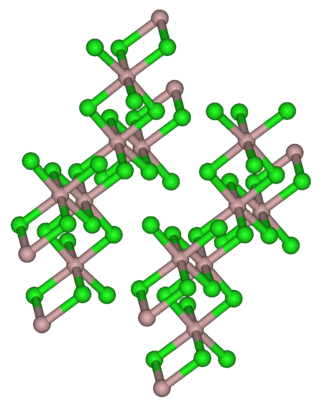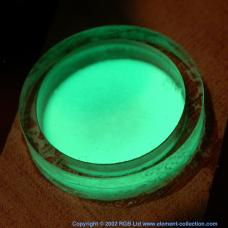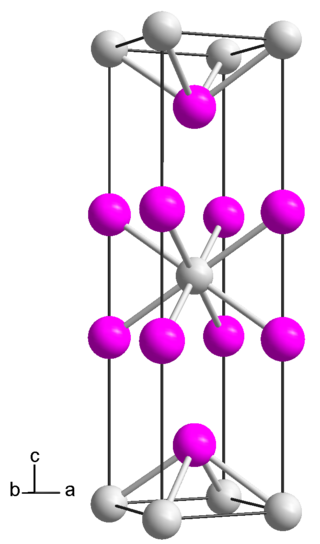
Iron(III) bromide is the chemical compound with the formula FeBr3. Also known as ferric bromide, this red-brown odorless compound is used as a Lewis acid catalyst in the halogenation of aromatic compounds. It dissolves in water to give acidic solutions.

Vanadium(III) bromide, also known as vanadium tribromide, describes the inorganic compounds with the formula VBr3 and its hydrates. The anhydrous material is a green-black solid. In terms of its structure, the compound is polymeric with octahedral vanadium(III) surrounded by six bromide ligands.

Indium(III) bromide, (indium tribromide), InBr3, is a chemical compound of indium and bromine. It is a Lewis acid and has been used in organic synthesis.

Berkelium forms a number of chemical compounds, where it normally exists in an oxidation state of +3 or +4, and behaves similarly to its lanthanide analogue, terbium. Like all actinides, berkelium easily dissolves in various aqueous inorganic acids, liberating gaseous hydrogen and converting into the trivalent oxidation state. This trivalent state is the most stable, especially in aqueous solutions, but tetravalent berkelium compounds are also known. The existence of divalent berkelium salts is uncertain and has only been reported in mixed lanthanum chloride-strontium chloride melts. Aqueous solutions of Bk3+ ions are green in most acids. The color of the Bk4+ ions is yellow in hydrochloric acid and orange-yellow in sulfuric acid. Berkelium does not react rapidly with oxygen at room temperature, possibly due to the formation of a protective oxide surface layer; however, it reacts with molten metals, hydrogen, halogens, chalcogens and pnictogens to form various binary compounds. Berkelium can also form several organometallic compounds.

Uranium triiodide is an inorganic compound with the chemical formula UI3. It is a black solid that is soluble in water.

Chromium(III) bromide is an inorganic compound with the chemical formula CrBr3. It is a dark colored solid that appears green in transmitted light but red with reflected light. It is used as a precursor to catalysts for the oligomerization of ethylene.

Einsteinium triiodide is an iodide of the synthetic actinide einsteinium which has the molecular formula EsI3. This crystalline salt is an amber-coloured solid. It glows red in the dark due to einsteinium's intense radioactivity.

Einsteinium(III) oxide is an oxide of the synthetic actinide einsteinium which has the molecular formula Es2O3. It is a colourless solid.

Chromium(II) bromide is the inorganic compound with the chemical formula CrBr2. Like many metal dihalides, CrBr2 adopts the "cadmium iodide structure" motif, i.e., it features sheets of octahedral Cr(II) centers interconnected by bridging bromide ligands. It is a white solid that dissolves in water to give blue solutions that are readily oxidized by air.

Promethium(III) chloride is a chemical compound of promethium and chlorine with the formula PmCl3. It is an ionic, water soluble, crystalline salt that glows in the dark with a pale blue or green light due to promethium's intense radioactivity.

Neptunium(III) chloride or neptunium trichloride is an inorganic compound with a chemical formula NpCl3. This salt is strongly radioactive.
Curium(III) bromide is the bromide salt of curium. It has an orthorhombic crystal structure.

Praseodymium diiodide is a chemical compound with the empirical formula of PrI2, consisting of praseodymium and iodine. It is an electride, with the ionic formula of Pr3+(I−)2e−, and therefore not a true praseodymium(II) compound.

Neodymium(II) bromide is an inorganic compound of neodymium and bromide.
Protactinium(V) bromide is an inorganic compound. It is a halide of protactinium, consisting of protactinium and bromine. It is radioactive and has a chemical formula of PaBr5, which is a red crystal of the monoclinic crystal system.
Promethium(III) iodide is an inorganic compound, with the chemical formula of PmI3. It is a red radioactive solid with a melting point of 695 °C.

Berkelium bromide is a bromide of berkelium, with the chemical formula BkBr3.

Germanium dibromide is a bromide of germanium with the chemical formula GeBr2.

Neptunium(III) iodide is the iodide of neptunium with the chemical formula NpI3.

Plutonium(III) iodide is the iodide of plutonium with the chemical formula PuI3.













